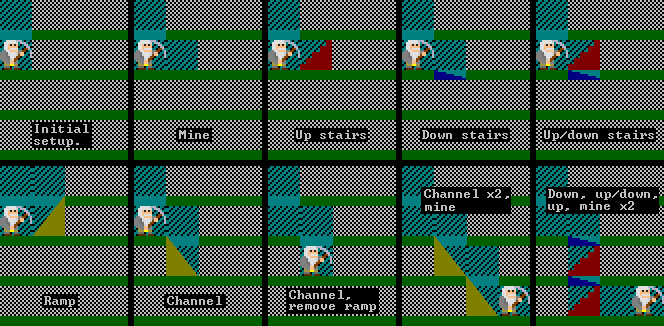- v50 information can now be added to pages in the main namespace. v0.47 information can still be found in the DF2014 namespace. See here for more details on the new versioning policy.
- Use this page to report any issues related to the migration.
Stairs
v52.04 · v0.47.05 This article is about the current version of DF.Note that some content may still need to be updated. |
Stairs allow creatures to travel across z-levels. They can be dug out or constructed. They need to be connected to other stairs of the appropriate type to function. Up stairs need to be built below down stairs. Up/down stairs function as both up and down stairs at once.
Caravan wagons can't travel across stairs -- you need ramps for those to be able to reach your trade depot.
Stairs do not block creature nor fluid movement. Falling creatures ignore stairs and may get seriously hurt if the real ground is several z-levels below them. Floor hatches can stop both falling creatures and liquid. They can also be locked to keep those pesky crundles from interrupting everything your dwarves could possibly do.
Down stairs reveal a tile directly beneath them. If it's wet or warm, the designation on this tile will be removed.
As with all constructions, stairs can only be removed by dwarves (ordered to do so - never on their own initiative) or cave-ins. Dug-out stairs can melt, if made from ice, but are otherwise just as resistant to damage - they can be removed by channeling the stair tile.
Stairs are fully capable of holding any amount of weight above them. An up stair or up/down stair will stop tiles falling during a cave-in; a down stair will not. However, when any stair tile is collapsed by a cave-in, the stairs disappear entirely.
Planning stairs
Stairs can be created in two different ways, or a combination of them:
- You can use the designations menu (d) to carve them out of a wall of unmined material (see digging).
- You can use the build menu (bC) to construct them in an open tile using material you have already gathered.
However, a down or up stair will give you sufficient access to the adjacent level to build connecting stairs. This means you can dig directly downwards or even directly upwards using stairs without needing any other forms of access to the area.
You can't designate an up stair on a square that has already been dug out; you have to carve one out of an existing wall or build instead. You can then build the matching down stair on the level above.
For a basic mineshaft/stair tutorial click here
Up stairs can be converted to up/down stairs by using dj to designate down stairs on them. However, down stairs cannot be converted to up/down stairs by using du to designate up stairs on them.
| Furniture | |
|---|---|
| Tools | |
| Access | |
| Constructions | |
| Machine and trap parts |
Axle • Gear assembly • Lever • Mechanism • Millstone • Pipe section • Pressure plate • Roller • Screw pump • Support • Trap • Water wheel • Windmill |
| Other buildings | |
| Related articles | |
